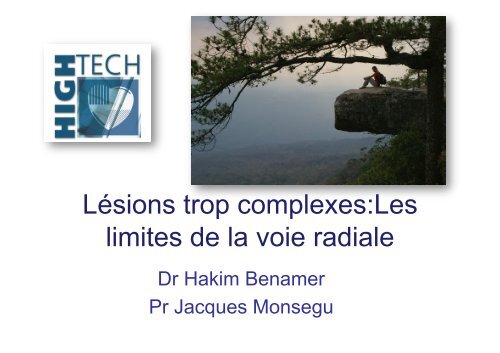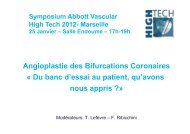Télécharger la présentation - Mediathèque du congrès de High ...
Télécharger la présentation - Mediathèque du congrès de High ...
Télécharger la présentation - Mediathèque du congrès de High ...
You also want an ePaper? Increase the reach of your titles
YUMPU automatically turns print PDFs into web optimized ePapers that Google loves.
Lésions trop complexes:Les<br />
limites <strong>de</strong> <strong>la</strong> voie radiale<br />
Dr Hakim Benamer<br />
Pr Jacques Monsegu
Mr BUS. Agé <strong>de</strong> 75 ans<br />
SCA ST – avec troponine à 1.5 ng/ml<br />
FdR: Tabagisme ancien<br />
ATCD cardio: 0<br />
ECG: T
Coronarographie le 3/12/2010<br />
Atteinte Bitroncu<strong>la</strong>ire IVA 2 et Cx
Coronarographie 3 <strong>de</strong>c 2010<br />
Atteinte Bitroncu<strong>la</strong>ire IVA 2 et Cx
Heart Team<br />
Traitement médical seul<br />
Angiop<strong>la</strong>stie: IVA et Cx ?<br />
Chirurgie<br />
Revascu<strong>la</strong>risation FFR guidée<br />
Angiop<strong>la</strong>stie<br />
Stratégie<br />
Voie d’abord
Angiop<strong>la</strong>sties <strong>de</strong> l‘IVA 2 et Cx 6 <strong>de</strong>c 2010<br />
Voie radiale droite (EBU 3.5 6F)<br />
Ballon apex 2.0x12 mm
Angiop<strong>la</strong>sties <strong>de</strong> l‘IVA 2 et Cx<br />
Circonflexe: Prédi<strong>la</strong>tation au ballon 2.5x12mm puis stent nu 3x14 mm
Résultat sur l‘IVA que faire?<br />
Malgré anchoring ballon dans <strong>la</strong> diagonale<br />
pas possible <strong>de</strong> passer le stent dans l’IVA
Cath<strong>la</strong>b Team<br />
Traitement médical seul ?<br />
Angiop<strong>la</strong>stie re<strong>du</strong>x <strong>de</strong> l’IVA?<br />
Chirurgie combinée?<br />
Stratégie<br />
Voie d’abord
Angiop<strong>la</strong>stie <strong>de</strong> l‘IVA 7 <strong>de</strong>c 2010<br />
Abord radial droit 6F EBU 3.75
Rotab<strong>la</strong>tor fraise <strong>de</strong> 1.25mm<br />
Plusieurs passages à 190.000 t/m
Inf<strong>la</strong>tions très prolongées, neutralisation <strong>de</strong><br />
l‘héparine, stent nu 2.5x14 mm<br />
Stent nu 2.5x14 mm puis Ballon 3.0x15 mm<br />
Que faire ?
Drainage
Assurer l‘hémodynamique<br />
Intubation/ Drainage/Cell saver
Assurer l‘hémodynamique<br />
Intubation/ Dreinage/Cell saver
Jostent Graft master 3x12 et 3x16 mm<br />
Anchoring ballon 2.5x12 mm<br />
7 F Radiale AL1
Résultat
Aval DES 2.25x15 mm<br />
Amont bifurcation DES 3x18 mm
En fin <strong>de</strong> procé<strong>du</strong>re (extubé et retrait drain)
Pourquoi autant d‘obstination creased as successive punctures were pour performed and<strong>la</strong> this<br />
was <strong>du</strong>e to vessel narrowing or occlusion. Although it is<br />
voie radiale?<br />
1 - Tri<strong>du</strong>x <strong>de</strong> radiale est-ce vraiment raisonnable?<br />
2 - Appui moins Thrombose bon déjà un <strong>de</strong> échec <strong>la</strong> <strong>de</strong> radiale franchissement <strong>du</strong> stent<br />
3 – Rota et voie radiale<br />
4 - 7 French par voie radiale dans<br />
primo<br />
un contexte<br />
ponction<br />
<strong>de</strong> survie!<br />
re<strong>du</strong>x p<br />
Ø 2.63±0.35 2.53±0.39 < 0.05<br />
Fig. 1. Time course of radial arterial diameter changes. No<br />
significant change in mean internal radial arterial diameter was<br />
observed between preproce<strong>du</strong>re and 1 day after proce<strong>du</strong>re for<br />
either an initial proce<strong>du</strong>re or a repeat proce<strong>du</strong>re. The mean<br />
radial arterial diameter was 2.63 0.35 mm before the initial<br />
proce<strong>du</strong>re and 2.51 0.29 mm 4.5 months after the first proce<strong>du</strong>re<br />
1771 (P < patients<br />
0.05). No significant difference in radial arterial<br />
diameter changes was observed for patients receiving the di-<br />
dont 117 re<strong>du</strong>x<br />
agnostic proce<strong>du</strong>re or PTCA.<br />
TABLE III. Proce<strong>du</strong>ral Results and Complications<br />
Initial Repeated<br />
Success rate (%) 114 (97.4) 115 (98.3)<br />
Cross-over a<br />
3 (2.6) 2 (1.7)<br />
Puncture failure<br />
Vascu<strong>la</strong>r complications (%)<br />
0 (0) 0 (0)<br />
Perforations 0 (0) 0 (0)<br />
Occlusion b<br />
0 (0) 3 (2.6)<br />
Major bleeding 0 (0) 0 (0)<br />
a Cross-over to femoral artery.<br />
b P 0.05.<br />
cases at 4 weeks, one case at 2 weeks); two cases had<br />
high SAR (0.91 and 0.93) and one case had small radial<br />
artery diameter (1.82 mm). Late recanalization of the<br />
occlu<strong>de</strong>d radial artery <strong>du</strong>ring the 12 weeks after proce<strong>du</strong>re<br />
was not observed in three cases (Table III).<br />
at the time of repeated use, <strong>du</strong>e maybe to the physician<br />
being skillful with radial artery puncture technique and<br />
catheter manipu<strong>la</strong>tion. Sakai et al. [10] have reported that<br />
the dropout rates for transradial approach (TRA) in-<br />
difficult to exp<strong>la</strong>in the mechanism of the vessel narrowing<br />
in our study, we <strong>de</strong>monstrated significant vessel<br />
narrowing after the transradial proce<strong>du</strong>re <strong>du</strong>ring longterm<br />
follow-up.<br />
Consi<strong>de</strong>ring recent increased concern of the radial<br />
artery as a grafting artery in coronary artery bypass<br />
grafts, radial artery occlusion or functional loss might be<br />
important problem in patients with transradial coronary<br />
proce<strong>du</strong>res [14,15]. In our study, the frequency of radial<br />
artery occlusion was 0% and 2.6% after the initial and<br />
repeated proce<strong>du</strong>re, respectively. Although it is difficult<br />
to find the factor of radial arterial occlusion <strong>du</strong>e to low<br />
Ratio 0.68 ± 0.12 0.70 ± 0.12 ns<br />
inci<strong>de</strong>nce of radial artery occlusion, we could hypothe-<br />
size that the bigger size of arterial sheath might incite<br />
more injury to the arterial puncture site. In the repeated<br />
proce<strong>du</strong>re, more PTCA was performed compared to the<br />
initial proce<strong>du</strong>re (P 0.04). This re<strong>la</strong>tion might be<br />
inferred from the other findings; the radial arterial occlusion<br />
was very low (0.8%) in transradial coronary angiography<br />
with a 4 Fr catheter (0.8%) [5] and 2.8% for<br />
transradial coronary artery angiop<strong>la</strong>sty using at least 6 Fr<br />
catheter in our data. The inci<strong>de</strong>nce of radial artery occlusion<br />
among 1,771 transradial coronary proce<strong>du</strong>res<br />
<strong>du</strong>ring the same study period was 11 patients (0.6%).<br />
Therefore, radial artery occlusion was higher in repeate<strong>du</strong>se<br />
patients than in total first-use patients (2.6% vs.<br />
0.7%; P 0.01). Radial artery occlusion is simi<strong>la</strong>r to<br />
Nagai et al. [13] (2%), but less than Saito et al. [16]<br />
(6.8%). Saito et al. [16] inclu<strong>de</strong>d cases with high proportion<br />
of SAR higher than 1.1, in contrast to SAR of less<br />
Yoo Cathet Cardiovasc Intervent 2003; 58: 301-4
Pourquoi autant d‘obstination pour <strong>la</strong><br />
voie radiale?<br />
1 - Tri<strong>du</strong>x <strong>de</strong> radiale est-ce vraiment raisonnable?<br />
2 - Appui moins bon déjà un échec <strong>de</strong> franchissement <strong>du</strong> stent<br />
3 - Rota et voie radiale<br />
4 - 7 French par voie radiale dans un contexte <strong>de</strong> survie!
Backup Force of Guiding Catheters for the Right Coronary<br />
Artery in Transfemoral and Transradial Interventions<br />
Ikari Y, J invasive Cardiol 2009;21:570–574
Backup Force of Guiding Catheters for the Right Coronary<br />
Artery in Transfemoral and Transradial Interventions<br />
Ikari Y, J invasive Cardiol 2009;21:570–574
Backup Force of Guiding Catheters for the Right Coronary<br />
Artery in Transfemoral and Transradial Interventions<br />
Ikari Y, J invasive Cardiol 2009;21:570–574
(guiding) Anchoring techniques<br />
Anchoring wire<br />
Anchoring balloon<br />
Anchoring stent<br />
Mother and child<br />
Tornus …
Pourquoi autant d‘obstination pour <strong>la</strong><br />
voie radiale?<br />
1 - Tri<strong>du</strong>x <strong>de</strong> radiale est-ce vraiment raisonnable<br />
2 - Appui moins bon déjà un échec <strong>de</strong> franchissement <strong>du</strong> stent<br />
3 - Rota et voie radiale<br />
4 - 7 French par voie radiale dans un contexte <strong>de</strong> survie!
1000<br />
0<br />
NCN : EVOLUTION DE L’ACTIVITE 2002-2006<br />
16<br />
1003<br />
1.6%<br />
26<br />
1043<br />
2.5%<br />
36<br />
1176<br />
3%<br />
ROTA 2002 ROTA 2003 ROTA 2004 ROTA 2005 ROTA 2006<br />
56<br />
4%<br />
1384<br />
62<br />
1375<br />
4,5%<br />
Ph Brunel RadialAlpes 2009
%<br />
2005, Between July and <strong>de</strong>cember<br />
29 french centers, All consecutive rotab<strong>la</strong>tor proce<strong>du</strong>res<br />
252 patients, 2.13% (0,3-6%) of all proce<strong>du</strong>res<br />
100<br />
80<br />
60<br />
40<br />
20<br />
0<br />
REGISTRE TAROT : FRANCE 6 mois<br />
22<br />
78<br />
RADIALE FEMORALE<br />
Ph Brunel RadialAlpes 2009
%<br />
10<br />
9<br />
8<br />
7<br />
6<br />
5<br />
4<br />
3<br />
2<br />
1<br />
0<br />
0,79<br />
5,95<br />
TAROT : COMPLICATIONS<br />
1,98<br />
(n=252)<br />
1,19 0,39 0,39<br />
Perforation dissection spasm slow flow burr stall gui<strong>de</strong> wire<br />
rupture<br />
Ph Brunel RadialAlpes 2009
Pourquoi autant d‘obstination pour <strong>la</strong><br />
voie radiale?<br />
1 - Tri<strong>du</strong>x <strong>de</strong> radiale est-ce vraiment raisonnable<br />
2 - Appui moins bon déjà un échec <strong>de</strong> franchissement <strong>du</strong> stent<br />
3 - Taille <strong>de</strong> <strong>la</strong> fraise<br />
4 - 7 French par voie radiale dans un contexte <strong>de</strong> survie!
Pourquoi autant d‘obstination pour <strong>la</strong><br />
voie radiale?<br />
1 - Tri<strong>du</strong>x <strong>de</strong> radiale est-ce vraiment raisonnable<br />
2 - Appui moins bon déjà un échec <strong>de</strong> franchissement <strong>du</strong> stent<br />
3 - Taille <strong>de</strong> <strong>la</strong> fraise<br />
4 - 7 French par voie radiale dans un contexte <strong>de</strong> survie!<br />
Yoo CCVI 2003 ; 58:301-304
O.D.<br />
2.00mm<br />
O.D.<br />
O.D. 2.29mm<br />
2.29mm<br />
O.D.<br />
2.16mm<br />
O.D.<br />
O.D. 2.49mm<br />
2.49mm<br />
O.D.<br />
2.29mm<br />
O.D.<br />
2.62mm<br />
O.D.<br />
2.62mm
Pourquoi autant d‘obstination pour <strong>la</strong><br />
voie radiale?<br />
1 - Tri<strong>du</strong>x <strong>de</strong> radiale est-ce vraiment raisonnable<br />
2 - Appui moins bon déjà un échec <strong>de</strong> franchissement <strong>du</strong> stent<br />
3 - Taille <strong>de</strong> <strong>la</strong> fraise<br />
4 - 7 French par voie radiale dans un contexte <strong>de</strong> survie!
Pourquoi autant d‘obstination pour <strong>la</strong><br />
voie radiale?<br />
1 - Tri<strong>du</strong>x <strong>de</strong> radiale est-ce vraiment raisonnable<br />
2 - Appui moins bon déjà un échec <strong>de</strong> franchissement <strong>du</strong> stent<br />
3 - Taille <strong>de</strong> <strong>la</strong> fraise<br />
4 - 7 French par voie radiale dans un contexte <strong>de</strong> survie!
Pourquoi autant d‘obstination pour <strong>la</strong><br />
voie radiale?<br />
1 - Tri<strong>du</strong>x <strong>de</strong> radiale est-ce vraiment raisonnable<br />
2 - Appui moins bon déjà un échec <strong>de</strong> franchissement <strong>du</strong> stent<br />
3 - Taille <strong>de</strong> <strong>la</strong> fraise<br />
4 - 7 French par voie radiale dans un contexte <strong>de</strong> survie!
CONCLUSIONS<br />
Toujours <strong>la</strong> Radiale<br />
Connaitre les atouts et <strong>de</strong>s faiblesses<br />
<strong>de</strong> <strong>la</strong> voie d’abord radiale pour arbitrer les choix<br />
techniques<br />
Faiblesses<br />
- Tailles variables<br />
- Variations anatomiques<br />
- Problèmes <strong>de</strong> support (Dte > Gche)






